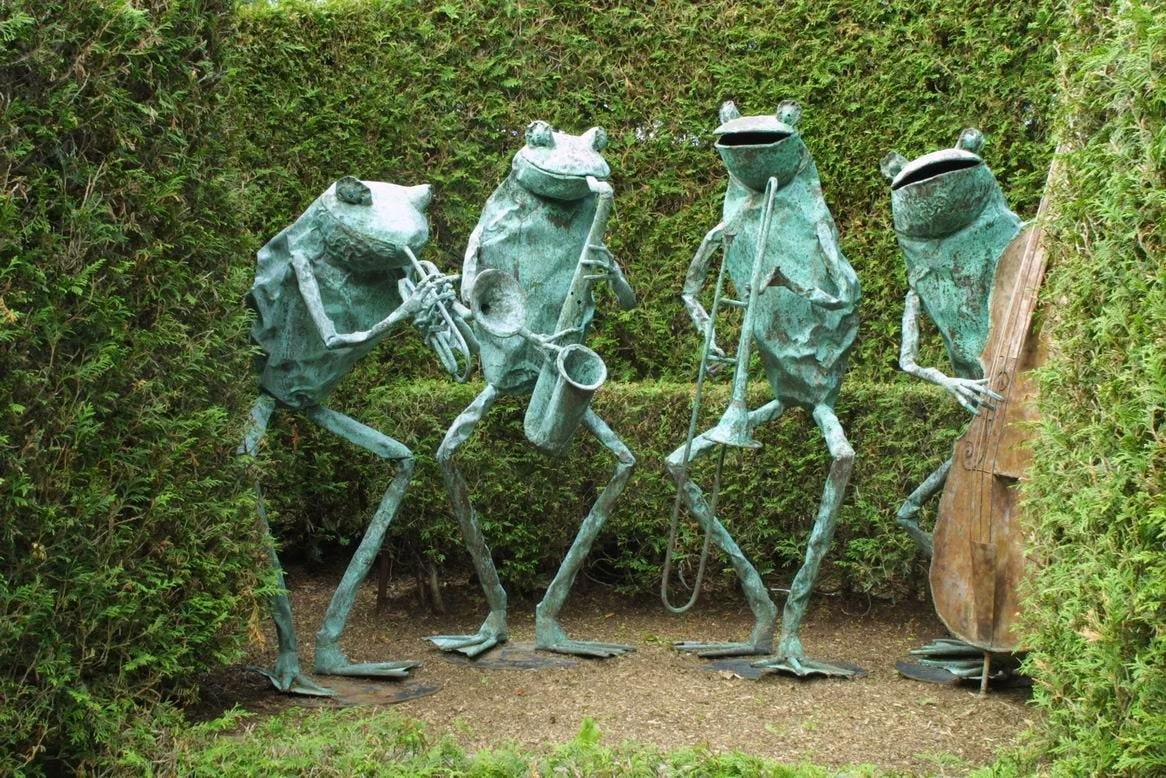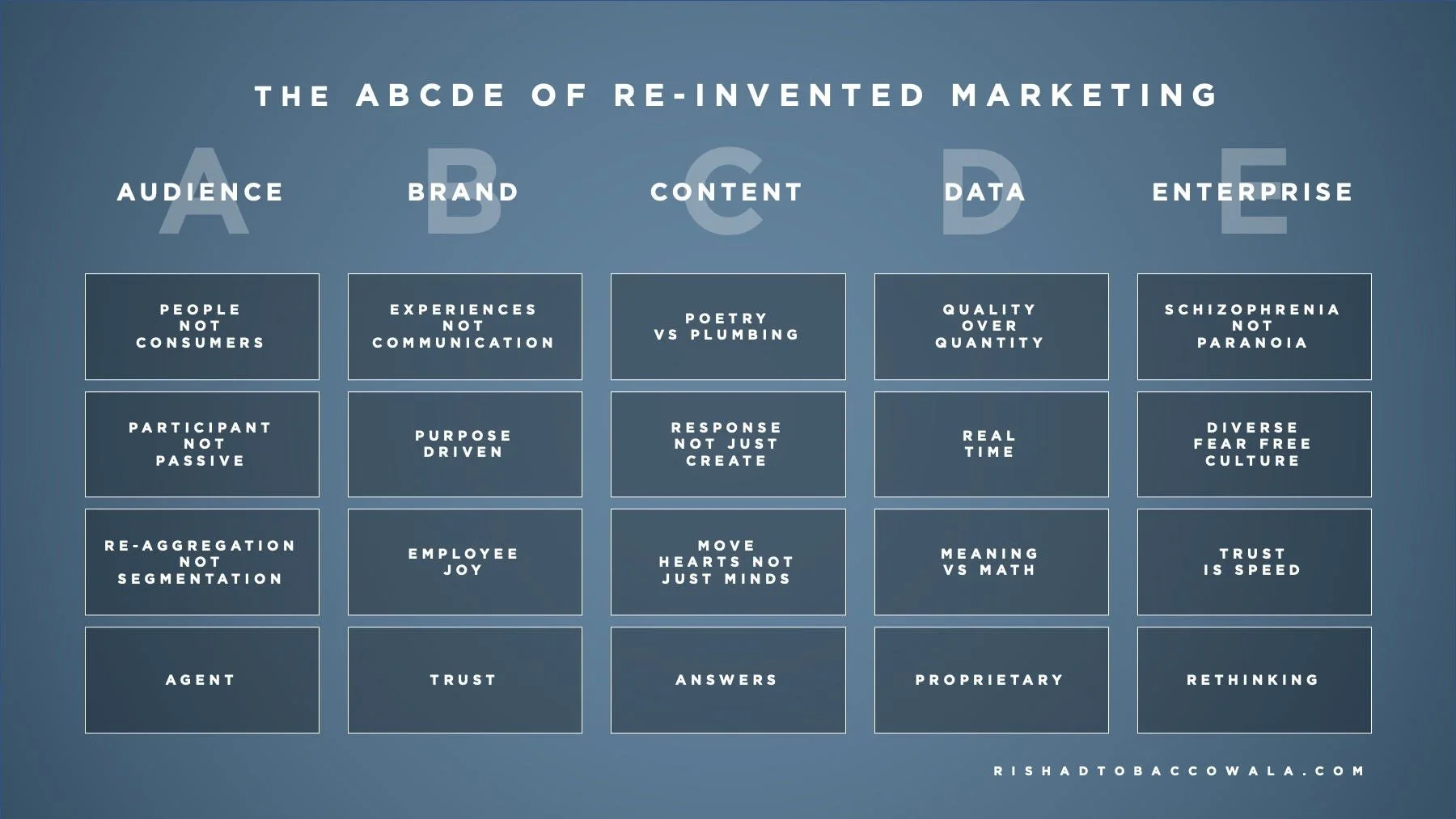The Garden Inside.
Art by Uta Barth
The World Is Too Much With Us.
The opening lines of “The World is Too Much With Us” by William Wordsworth:
The world is too much with us; late and soon,
Getting and spending, we lay waste our powers;—
Little we see in Nature that is ours;
We have given our hearts away, a sordid boon!
Today we are buffeted by a tsunami of external drama which keeps us unmoored.
This in addition to an algorithmically optimized drip drip drug flow of attention hungry engagement orifices seek to bend us to look here, look there, feel this and feel that.
The outside world is often too much with us.
But it is in internal changes where the meaning lies.
Looking is not the same as seeing.
A few years ago an exhibit at The Modern Wing of the Art Institute of Chicago featured the work of a Los Angles artist named Uta Barth.
Ms Barth leverages photography in a novel way to get you to both see what you may not have seen but as importantly to make you forget what you are looking at but be aware of the resultant feeling.
Her work which can be simple as conveying the feeling of light on a curtain or a shadow on a kitchen wall is inspired by a line from Robert Irwin which goes…“Seeing is forgetting the name of the thing one sees”.
We often look but do we see?
The Garden Inside
Have always enjoyed parks and gardens and am lucky to live by the lakefront in Chicago which is adorned with parks. These are great spaces to reflect, refresh and repair, particularly in these drama filled times.
One of the parks in Chicago—Lurie Garden in Millenium Park— has been designed by Pier Oudolf who is considered among the greatest Landscape Designers in the World (he also landscape designed the High Line in New York). His books are filled with breathtaking foliage that integrate and blend into nature likes works of art.
But there is one garden that may stand above them all
In the Charlevoix region of Quebec there lies a private garden which covers more than 20 acres and is called Les Quatre Vents ( The Four Winds). It is considered amongst the finest private gardens in the world ( it is opened a few times a year to the public).
The garden was created by one person, Francis Cabot, as his life work that blends creativity and passion and it is simply the most breathtaking places one can imagine.
Francis Cabot believed that Gardens are like art and have the power to change you. And unlike other art, which may affect you differently over time, because you have changed over time, a garden is itself always changing. Francis designed his Garden to lift the soul of people who walked through it.
He wanted you to come out different after the experience.
Cabot has sculpted, designed and tended a variety of different types of structures and styles —a total of 24 different experiences—including a Japanese garden, a French Pigeonnier – pigeonnier is French for both pigeon coop and pigeonhole – and integrated water ways and a variety of bridges all using natural materials from place of origin. The Japanese tea house was built by Japanese artists using wood from Japan that was aged for years.
Here is a peek at Les Quatre Vents…
There is an amazing book called “The Greater Perfection” filled with pictures and Francis Cabot explaining his life’s work, which I would recommend to everyone if it were affordable and easily available.
Doctors would prescribe it would for the soul.
However, there is a wonderful movie on Francis Cabot called “The Gardener” which is available for free on Amazon if you are a prime member. Take a look at this two minute trailer and it alone should lift you and calm you down.
One prescription for the pressures and challenges we face is to take a walk in a garden.
Regardless, it is key to remind ourselves of Francis Cabot’s belief that every individual is creative and we have a garden within ourselves that we need to tend to so that we can bloom…
4 Keys to Leading Today.
Companies with a disproportionate share of talent passionately aligned against a common goal usually are the ones that grows faster, create great economic value and attract and retain customers and clients for the long run.
This alchemy of wealth, value and alignment is often created by the wizardry of leaders.
Leadership has never been as important today in a world in midst of great transformation.
In the end great leadership come down these four components:
Leaders acknowledge, face and communicate reality.
People admire and respect people and not titles since titles are bestowed while leadership is earned.
The five characteristics of great leaders are capability, integrity, empathy, vulnerability and inspiration.
Great leaders scale their talents by creating a fabric of great culture.
1. Reality.
A key to leadership is to solve challenges and address problems. This requires confronting issues versus looking away or hoping some form of magical thinking will make them go away.
One cannot hope to get people to follow us if they suspect we are not addressing real issues and challenges however difficult they may be.
Great leaders ensure they never set themselves for self-defeat.
They do this by constantly taking temperature of the marketplace, anticipating opposing points of view and paying close attention to underdogs and outliers who might change the rules of the game.
They focus on future competitive advantage and not yesterday’s game.
2. Respectful Admiration.
Without the hearts and minds of one’s team one is not a leader but a ruler.
Rulers leverage fear, project power and exploit insecurity.
Employees genuflect, fall in line, salute and pander to the hollow and bloated boss, while they silently seethe, plot insurrection or practice defection.
All rulers fall and increasingly they are failing and falling faster as they flail and rail with great cacophony.
But facts are stubborn things.
Reality has a habit of breaking in.
Gravity does not care if you tweet that it is fake.
It kills those who step off cliffs and tall buildings.
Leaders on the other hand are respected and admired both for their operating and strategic skills but they earn the most important currency of the time that allows them to buy time and alignment in changing times.
The currency of trust.
3. Five Characteristic of Leaders.
a) Capability: To be a leader you have to be capable in your field of work or craft. You have to know your shit. You have to keep improving your skill. Doctors will not listen doctors who are not great at medicine. A creative will not respect someone whose body of work they do not admire.
b) Integrity: Can one be trusted? Are we transparent about the ingredients of our decision making. Does one look for opposing evidence and use real facts ?
c) Empathy: Leaders can see from other points of view and they understand that employees are people and work is but a sliver of their being. They understand and they listen. They care. They do this both for employees and for customers.
d) Vulnerability: Great leaders acknowledge mistakes. They know they do not have all the answers. This means they are open to criticism and correction and they surround themselves with skill sets that offset and balance their areas of weakness.
e) Inspiration: How do leaders face and acknowledge reality and hard truth but still get people to unite, align and take the challenges head on? They do so by recognizing that people choose with their hearts and not their minds. They inspire through a combination of personal example and storytelling.
4. Culture.
It has been said that “culture eats strategy” and often when companies decay (Boeing) or resurrect ( Microsoft) or have distinctly different outcomes in the same industry ( Delta vs most other airlines) a key determinant is the culture. What it is like, how it is improving or how it is getting worse.
The culture of an organization is revealed in how people behave when no one is looking or monitoring their behavior.
Culture is about the relationships, mindsets and goals of people and not a place, a program or an operating manual. It is something leaders set, correct and support, but culture is how leaders treat people and how people feel about themselves, their company and their colleagues.
Companies with great cultures tend to have employees who feel most of the following about their jobs and companies:
Fair/ Good Compensation: If people are not paid adequately or fairly it really hard to have a good culture.
Recognition: Great cultures recognize contributors and leaders do not step into their teams video stealing credit.
Autonomy: People are trusted to deliver with limited monitoring and can access resources to do so.
Purpose: They believe in the purpose and values of the company and see the role of their company beyond that of just profit but doing good for society or community.
Growth: The company is growing, has a plan for growth or even if static, the individual is growing and teams are growing by being given opportunities to learn and build new skills. The focus is on multiplying versus dividing.
Connectedness: People feel connected to each other and to their leadership. They feel free to speak up and share and even joke.
While some leaders today may disappoint there are many many amazing leaders across all aspects of business, education and government who we can all learn from by paying as much attention to those who lift us up versus those who bring us down.
Think like an Immigrant.
On March 19, during a closing keynote of the Adtech Economic Forum at the Times Center in New York, I was asked to summarize and build on the thoughts of all of the other speakers from the Angel Investing, Venture Capital, Private Equity, Corporate Strategics and Hedge Fund businesses who invest in Advertising and Marketing Technologies.
Every speaker mentioned the dramatic changes taking place in the marketing and investing eco-system driven by marketplace, financial, political and technological disruptions and the challenges and opportunities of operating in such an environment.
It seems to be a revolutionary time and many existing business models and past assumptions are at risk and the speed of change seems to be accelerating.
Summarizing their thinking, I suggested that in order to thrive we all learn to…
Think like an Immigrant.
World class leaders and companies rarely get defeated.
They decide to defeat themselves by a) not taking emerging competitors with new models seriously, b) paying scant attention to underdogs with fewer resource and different approaches, and/or c) by refusing to align with the forces of the future.
We can all learn from immigrants.
a) Immigrants often think like outsiders.
Individuals and companies that thrive over the long run view their business from external perspectives and not just internal perspectives.
They understand the viewpoints of future competitors, changing consumer and customer needs and they realize the biggest threats and opportunities come from outside their categories ( eg. Tesla and Uber came from outside the traditional Auto Industry, Google and Meta changed the content industry more than any newspaper, magazine or television conglomerate).
But many leaders and businesses benchmark against existing competitors, go to the same conferences, and stay in the lane of well trodden paths of thinking.
Maybe its time to think like an outsider.
b) Immigrants often think like underdogs.
Underdogs use technology, drive, and ingenuity to find ways to leverage what they have or what others have to change the rules of the game.
They do not view the moat surrounding the castle as a something to navigate but a source of material to flood the castle with by changing the rules of the game!
Even Meta was surprised that what they thought was a moat which was their social graph was used against them. TikTok practiced asymmetric warfare by eschewing the social graph and replacing it with an interest graph. Its algorithm and learning loops allowed individuals to be exposed to a spectrum of great content without having to bring any friends or create any content!
c) Immigrants think with an emphasis on the future
Short or mid term sacrifices and pain is endured to build a future for themselves and families just like great companies think beyond the quarter and the year but in long time periods.
These firms and leaders focus on compound improvement, constant iteration and experimentation and an enduring long term vision whether it be Amazon or Microsoft or Netflix or recently Delta who by taking the long view became the most valuable and biggest airline.
We are all immigrants in a way.
While 27 percent of the United States population is first or second generation immigrant are we not all immigrants in a way that we are all immigrating to a new land called the future?
Margaret Mead wrote “After all, we are all immigrants to the future; none of us is a native in that land.”
And Mohsin Hamid wrote “We are all migrants through time”
Think like an Immigrant.
Rob Beeler and Tom Triscari who co-founded the Adtech Forum had so much interest and resonance from their audience about the “Think like an Immigrant” idea that they have designed and produced men and women’s t-shirts in a range of colors and sizes which are available here. ( I have no economic interest in the sale of the t-shirts)
As one grows more seasoned one dislikes complexity, confusion and constipation.
Time is of essence. Speed is key. Simplicity reduces the need to dither, dally and delay.
So here is one chart to explain all the key changes that have occurred and will occur in marketing.
Clearly the challenges and opportunities facing companies are complex. Here is framework, the ABCDE of Re-invented Marketing, that attempts to simplify without dumbing down the key issues that we all have to face.
The Five Shifts: Audience, Brand, Content, Data and Enterprise.
Audience: Who we are marketing too, how we reach them, and their mindset has shifted greatly over the past decade.
a) From Consumers to People with God Like Power: The biggest mistake companies make is they view things through the lens of their Brands and see us as Consumers.
Very few people define themselves by the brand they consume.
Even an incredible company like Procter and Gamble with dozens of billion-dollar brands cannot understand people if they looked only through the lens of their Brands (they are too sophisticated to do that) because at the core all their Brands are about dirt removal. Dirt removal from your teeth, clothes, dishes, butt, kids butt etc. Do you define yourself by dirt removal?
Or consider brands that fixate on wanting to have “relationship” with you. Very few people want to have a relationship with a brand. They want their headache to go away rather than enter a relationship with Tylenol.
It is key to think about people and not consumers.
b) From passive to interactive: A decade and a half ago we thought of people we marketed to as an audience since they were primarily passive receivers. Today they create, share, and interact and some of them are so impactful that we call them Influencers and Creators and there is an entire ecosystem of Influencer and Marketing.
In many cases they begin a “campaign” and marketers respond to what has been created!
AI is now introducing a new interface to supplement and sometimes replace search and streams which are the two current interfaces. Conversations. Not just chat but constant back and forth.
c) From Segmentation to Re-aggregation: As media becomes almost completely digital, we need to understand that people come to digital media one at a time. There is no mass media that we segment by finding channels or magazines with high proportion of the people we are marketing too. The power of Google, Facebook and increasingly connected television is the ability of self-service tools to buy and scale individual interactions one at a time. We no longer are going from a cow of a mass audience to a steak of a segmented audience. Rather we are re-aggregating single pieces of mince into a hamburger.
d)From Reaching People to Reaching People’s “Chiefs of Stuff”: As marketers begin to use persona’s to better understand people and utilize agentic ai to connect with the people they should realize that the people they wish to sell and persuade to will also have agents to find, filter and negotiate on their behalf. These “Chief’s of Stuff’ will be instructed and will seek but they may not feel so how will that change marketing?
Brands: Brands continue to be important but the way they are built is changing greatly. Today, Experiences, Purpose, Employee Joy and Trust matter the most in building Brands. These changes explain the long-term secular decline of advertising and communication but the renaissance and rise of marketing.
a) From Communication to Experiences: Jeff Bezos of Amazon said some companies spend 30 percent of resources on building a better product or experience and 70 percent telling people about it. Others spend 70 percent of their effort on product and service and 30 percent on telling people about it. Jeff said Amazon was the latter company.
In an era of empowered people connected to each other the focus should be on the experience. The brand is the experience and experiences are the brand. We will be moving from omni-media to experience stacks where businesses combine physical, digital and immersive experiences to connect and resonate with people.
b) From Great Words to Purposeful Behavior: Purpose matters more than ever especially in today’s time of social, financial and health challenges. Purpose is not some words left to wander on a lonely corporate website but the way a company or brand behaves.
c) Employees as Brand Advocates and Key to Purpose and Experience: If a company does not invest and treat its employees well it will be very challenged on both the experience front (angry, tired, and worried employees do not deliver great products or experiences) but also any purpose statement rings hollow if you cannot look after your own people.
We will soon understand that even more important than net promoter scores of customers are the net joy scores of employees.
d) Trust: A brand is a trust mark and in today’s low trust age, brand’s will distinguish themselves through trust. In an AI age where no video, photo or fact can be trusted a great and trusted brand will be a good house keeping seal.
Content: Content has always been a key to marketing. The four big differences are that there is much more of it, it is far faster, there are many new ways of making it and we need to get to the point quickly with answers.
a) Think Poetry and not just Plumbing: Today in a world of granular targeting and algorithmic trading we can get the right interaction to the right person at the right time. But what are we paying as much attention to the interaction as getting it there? We must think of the poetry and not just the plumbing. AI will finally allow the messaging and interactions to be personalized at scale.
b) Think response not just creation: Many campaigns are started by people. Memes or perspectives of about your brand can ricochet all over the world and we need to ensure that in today’s world of weaponized platforms you have a world class risk intelligence partner and a rapid action team to identify and manage detractors and other instigators. As importantly influencers often have far larger audiences and are more trusted than many media companies. What we call mainstream media is actually niche and what we call niche is mainstream. AI is the slingshot that will turbo-charge this shift to the the Podcasters, Substackers, and Tiktokers, further reducing the benefits of scale.
c) People choose with their hearts and use numbers to justify what they do: Content that moves people is content that moves product.
d) The Answer Economy vs the Information Economy: One of the reasons search engine marketing worked was because increasingly search did not. Too many websites and much content marketing is where we look for answers but we get links or click bait headlines or diarrhea filled pages of junk we have to wade through. That era might be ending in the Answer Age which AI is bring about.
Data: Data is key to future of marketing. It is like electricity. It illuminates. Without strong data a company cannot compete. It is necessary. But it is not sufficient. Because just like few companies differentiate themselves by how they use electricity, very few companies will find a competitive edge in data. It will be a key ingredient and not the be all or end all of strategy. And very few companies will be able to live on their own data. The four areas to focus on data are quality, real time, meaning and connectedness
a) Quality versus Quantity: If 90 percent on data has been created in the last two years most companies “data lakes” are filled with muck/mud/ slime and lots of dead fish.
b) Real Time Access and not just Ownership: First party relationships with people who buy from you are key. Using only platforms as the roadways to reach them will lead to high tolls or blockades. But first party data alone is not enough and how to access and partner with other firms both to build a better understanding and bridge to people but also to design better and more comprehensive products and solutions.
c) Meaning versus Math: Data is not information, knowledge, or wisdom. Algorithms are bias embedded in code. How do you integrate, interpolate, interrogate data, and involved diverse mindsets, interconnect to larger trends and add imagination to make meaning from math?
d) Connectedness: A case can be made that the reason Apple has fallen behind in AI is because it was so fixated on privacy that it knee-capped itself while giving rise to Meta’s AI capabilities which came about because of a loss of Apple signals. Apple by roping people out roped itself in. Without connection to a broader eco-system data is nothing. Connected data allows one to better know the people one is serving but also is also key to connecting them seamlessly through experiences will be. Connection is critical.
Enterprise: If a company is to deliver experiences in a world of people with God like power, while steering itself with a purpose and looking after its stakeholders particularly its employees but also making sure it delivers tangible results today, it will have to sculpt itself into a new form by building new muscles. The future does not fit in the containers of the past.
a) The Paranoid Die. The Schizophrenic Thrive: Andy Grove the late CEO of Intel said only the paranoid survive. In today’s age where we need to connect and work together this leads to polarized and insular thinking which explains why Intel has become a shell of itself and is a shadow in the world of Taiwan Semi-Conductor, Nvidia, AMD and ARM.
Rather than Paranoia the right mindset is Schizophrenia. Companies should run two models. One focused on delivering today and the other on building a new tomorrow where some of the best talents are given all the assets of the companies and none of the liabilities and asked to do whatever it takes to move into the future including eating and harming today’s cash cows.
b) Culture is the result of what fear free, diverse people do when no one is watching: To navigate change companies need fear free cultures of diverse people and mindsets led by leaders who continuously learn, incentivize and train for change and worship no sacred cows.
c) Trust is speed: If a company wants to be high velocity it must be one built on trust. A company where intent is clear, decision making transparent and leaders are accountable is one where speed, innovation happens and “cover your ass deck writing” and meetings to prepare for meetings are minimized.
d) Rethinking: It is not just marketing that will change but marketers will need to also change. AI for instance will not only make marketing more effective and efficient but it will create both existential risk and opportunity. If the NY Times had used digital just to make their printing presses run more efficiently and their truck routes more effective they would not be as successful as they are. They realized that the new world meant no need for printing presses or trucks or page one meetings or a daily newspaper. Smart marketers realize that making their current marketing approaches more efficient and effective is the least important of the real challenges and opportunities of the new era. It is time to upgrade one’s operating system and shift mindsets and rethink the organization, category, competitive sets and much more.
How to See Better.
Photographer Unknown
The best photographers become so not because of their equipment, or the exotic locations they are sent to, or the incredible opportunities to photograph celebrities or events they are offered, but because they have perfected the art of seeing.
This art of seeing can be honed via practice and in The Photographer's Eye by John Szarkowski he identifies five keys to see like a photographer which are: 1) The Thing Itself, 2) The Detail, 3) The Frame, 4) Time and 5) Vantage Point.
Each one of these five are also great tools to use to improve thinking for personal and business decisions.
Bubble David Smith
The Thing Itself.
One of the keys to proper thinking is to see the situation for what it is.
To face reality. To collect the facts. To not have FOFO ( the fear of finding out).
If we traffic in magical thinking, look away from the problem and assume away what is real it is hard to think straight.
Street Tommy Jiang
The Detail.
Every challenge and opportunity lies in the details. One or two key variables that the enterprise turns on. Forgetting that interest rates could go up and that you can not lend or lease in the long term while borrowing in the short term led to Silicon Valley Bank’s and WeWork’s implosion.
Similarly in the sea of data lies the pattern which reveals the meaning.
In hindsight the key details and critical data are obvious. But to reveal what drives the machine and makes the clock tick we need to analyze and scenario plan.
The shifting of parameters often reveals the key variables we take for granted or need to be aware of.
Ask what key details or critical data that drive assumptions. And then think about when they change what new new risks or opportunities are created?
In His Likeness David Callinan
The Frame.
Framing a problem is a key to solving it.
If one does not start with the right question the solution might never have a chance of being correct.
Similarly framing a situation or an offer is key to how someone looks at it.
Everything is in context with everything else and this ability to frame is an essential tool to the best problem solvers and sales people.
The Walk through Life Howard Walker
Time.
Placing things in perspective from a past, present and future lens allow one to stress test one’s thoughts.
Scavenging the past reveals treasures for the future but stay frozen in the past and there will be not future to treasure. So it is critical to both move forward from yesterday to today as well as backward from tomorrow to today.
In addition, it reminds us that timing is key to understand when to launch a product or service.
Too soon or too late is a problem as is too slow or too fast.
A decision that can be reversed should be made fast versus one that cannot should be marinated in time.
Dump Mayk Wendt
Vantage Point.
In a famous Japanese movie Rashomon truth depends on where one stands. The same crime when viewed from four vantage points lead to different conclusions as to what actually happened..
Being able to think from the perspective of a buyer if one is a seller, from a disrupter if one is a legacy company or having the empathy to understand other peoples perspective are key to clear thinking.
So next time when making a decision or evaluating a situation 1) look hard at the situation or thing itself to make sure the facts are understood, 2) parse the detail and the data, 3) frame the question or the solution, 4) interrogate it with time scenarios and 5) view it from different vantage points.





















